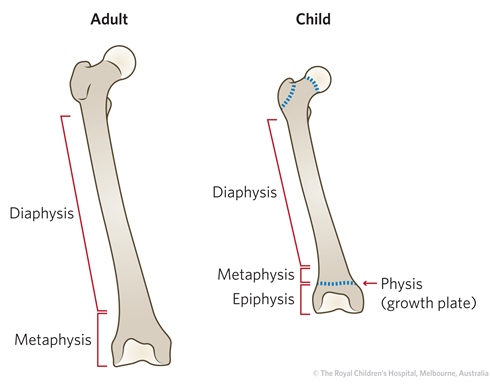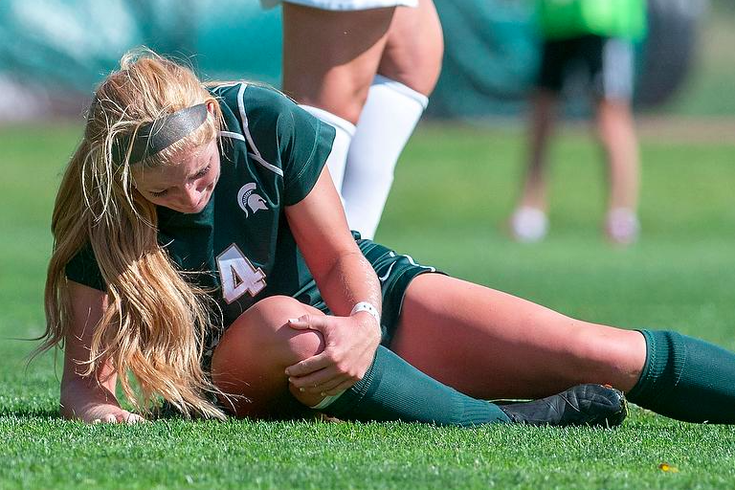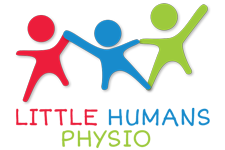The bodies of children and adolescents are constantly changing during growth. This can include changes to the hormonal, anatomical and musculoskeletal systems. Growth affects multiple areas of the musculoskeletal system. These include:
Muscles:
During a growth spurt a child’s bones lengthen before their muscles. This can affect muscle flexibility and strength. Unfortunately, larger limbs require more control during powerful movements such as jumping/running. During a rapid growth spurt children may be at a higher risk of injury if they have strength deficits or poor flexibility.
Growth plates (known as Epiphyseal plate):
Growth plates are active areas of developing tissue that allow a bone to lengthen as a child grows. Growth plates can be more susceptible to fractures as they are a softer/weaker section of skeletal bone. Fractures of the growth plates usually occur as a result of contact sports or high impact collisions. Injury to the growth plates can affect bony growth and therefore require immediate assessment and treatment.

Fractures that occur due to overuse are known as stress fractures. Stress fractures occur due to repetitive loading of one area of the body. A stress fracture occurs when muscles become fatigued and no longer distribute force causing bone to be overloaded. Stress fractures can occur in children who “ specialise” in only one sport i.e performing the same activities repetitively.
Apophysis
Apophyses are sites where muscle attach to bone. Apophyses are vulnerable to repetitive forces especially during rapid periods of growth. This is again due to long bones (support the weight of the body e.g thigh bone) growing quicker than muscles, causing muscles to tighten and pull on the sensitive apophysis. Common areas of apophysitis are the ankle, where the calf attaches onto the heel (known as Sever’s disease) and the knee where the quadriceps attaches below the knee (known as Osgood Schlatter disease).
 Ligaments
Ligaments
Ligaments attach bone to bone. Injuries to ligaments are known as sprains. Ligament sprains are less common in children because of their increased elasticity and their close proximity to the soft/ weak growth plate. Children who present with symptoms similar to a ligament sprain may actually have an avulsion fracture. This occurs when a ligament pulls off a piece of bone instead of tearing.

Adolescents, particularly female are at a higher risk of ligament injuries during or just prior to their peak growth spurt. This is due to a change in strength ratios between the hamstring and quadriceps muscles during puberty. Males experience an a 148% increase in quadriceps strength and 179% increase in hamstring strength compared to the 44% and 27% increases demonstrated by females.

If your child has an injury they may benefit from a physiotherapy review. If you would like to make an appointment for your child you can contact us or book an appointment online.
References:
Adirim, T., & Cheng, T. (2003). Overview of injuries in the young athlete. Sports Medicine, 33(1), 75-81.
Cassas, K., & Cassettari-Wayhs, A. (2006). Childhood and adolescent sports related overuse injuries. American Family Medicine, 73(6), 1014-1022.
Hewitt, T., Ford, K., Hoogenboom, B., & Myer, G. (2010). Understanding and preventing ACL injuries: Current biomechanical and epidemiological considerations- Update 2010. North American Journal of Sports Physical Therapy, 5(4), 234-251.
Kernozek, T., Torry, M., Van Hoof, H., Cowley, H., & Tanner, S. (2005). Gender differences in frontal and sagittal plane biomechanics during drop landings. Medicine and Science in Sports and Exercise, 37(6), 1003-1012.
Kidd, P., McCoy, C, & Steenbergen, L. (2000). Repetitive strain injuries in youth. Journal of American Association of Nurse Practitioners, 12(10), 413-426.


